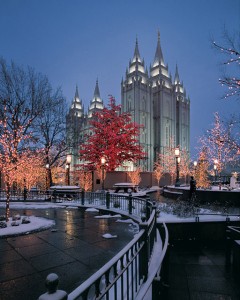By Annie L. Henderson Cechini
 In the short film Between Heaven and Earth, Krister Stendahl, former Dean of the Harvard Divinity School, states that in any interfaith discussion, individuals should never compare bests with worsts. Stendahl reasons that, “Most people think of their own tradition as it is at its best, and they use caricatures of the others.” I am a member of the Church of Jesus Christ of Latter-Day Saints, or LDS Church. It’s a mouthful, I know, and most people therefore refer to my church as the Mormon Church.
In the short film Between Heaven and Earth, Krister Stendahl, former Dean of the Harvard Divinity School, states that in any interfaith discussion, individuals should never compare bests with worsts. Stendahl reasons that, “Most people think of their own tradition as it is at its best, and they use caricatures of the others.” I am a member of the Church of Jesus Christ of Latter-Day Saints, or LDS Church. It’s a mouthful, I know, and most people therefore refer to my church as the Mormon Church.
Fig. 1: Salt Lake City Temple
Immediately, some of you readers are pulling out the mental sketchbooks and charcoal to begin work on caricatures just from reading that name. In composing this article, I am driven by my experience of being viewed through cracker-jack lenses because of said caricatures. These inaccurate and sometimes painful sketches abound in even highly respectable minds and institutions regarding the Church of Jesus Christ of Latter-Day Saints.
A little over a year ago, I served an 18 month mission in Washington D.C. In addition to having the pleasure of working with families in the surrounding areas, I was also asked to serve part time in the Visitor’s Center located on temple property. I was asked many questions, and spent many hours studying in order to answer competently. I will respond to some of the questions I received then in an effort to dispel some modern ‘Mormon’ mythology concerning temples. I will show that a) the concept of temples is not new; rather it is worldwide and cross-cultural, b) historical background on temples will shed further light on the subject, c) there is a biblical connection between ancient and modern temples, and d) there are surprisingly simple answers to the questions about the Mormon temple.
Next: Global Temples
